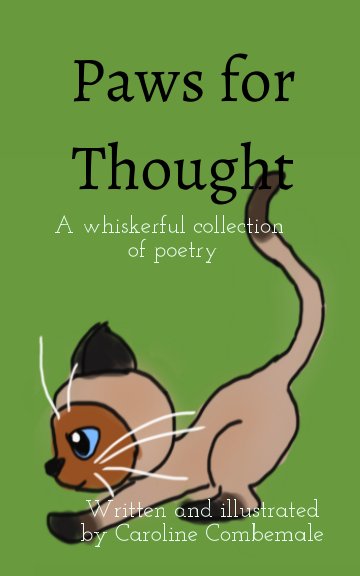Paws for Thought
A whiskerful collection of poetry
by Caroline Combemale
This is the price your customers see. Edit price list
About the Book
I wrote Paws for Thought: A Whiskerful Collection of Poetry to combine two of my greatest loves; cats, and poetry. As an educator, my foremost goal is to ensure that my students have access to appropriate resources and excellent pedagogy. While compiling my own poetry, I read fascinating articles about the importance of poetry in the classroom. I was especially inspired by an edutopia article in which Matthew James Friday, an international teacher, writes about poetry “broaden[ing] reading choices” and providing new English speakers a “less intimidating” opportunity to write in English (Friday). This statement resonated with me as I work with many students for whom English is a second language.
Since I have experience working with children of all backgrounds and abilities, I recognize the importance of making language accessible. Promoting accessible language must include supporting varied forms of writing.
Children’s Poetry as a Teaching Tool, an article published in The Clearing House and written by Richard L. Sartore, details the poetic deficiencies in our modern classrooms. He describes the importance of rhyme and rhythm in child development by making connections to Nursery Rhymes. Sartore expresses that “youngsters delight in listening to the sounds” of poetry, even when the words are not understood (Sartore). As our children’s attention spans continue to decrease, we need to become more creative in the ways in which we incorporate written art. An engaging written form should be celebrated as we connect with students. Poetry should be used to inspire and support children as ideas flow through the classroom. I invite you to explore the resources referenced in previous pages and include poetry in your lesson plans. Your students deserve it.
Since I have experience working with children of all backgrounds and abilities, I recognize the importance of making language accessible. Promoting accessible language must include supporting varied forms of writing.
Children’s Poetry as a Teaching Tool, an article published in The Clearing House and written by Richard L. Sartore, details the poetic deficiencies in our modern classrooms. He describes the importance of rhyme and rhythm in child development by making connections to Nursery Rhymes. Sartore expresses that “youngsters delight in listening to the sounds” of poetry, even when the words are not understood (Sartore). As our children’s attention spans continue to decrease, we need to become more creative in the ways in which we incorporate written art. An engaging written form should be celebrated as we connect with students. Poetry should be used to inspire and support children as ideas flow through the classroom. I invite you to explore the resources referenced in previous pages and include poetry in your lesson plans. Your students deserve it.
See More

